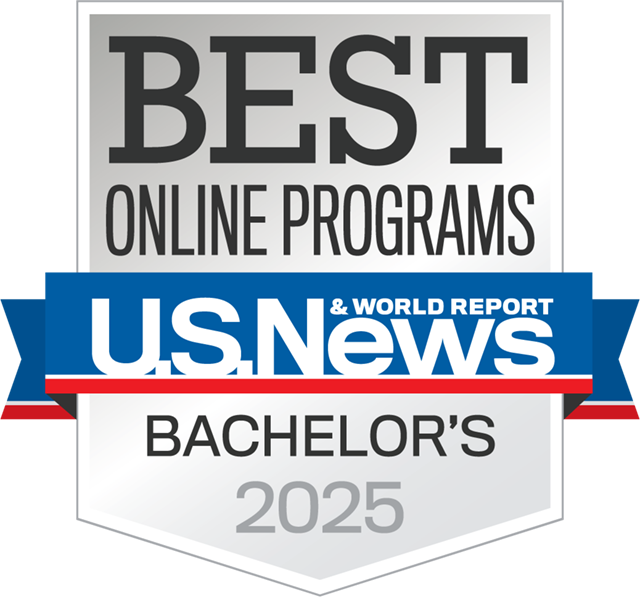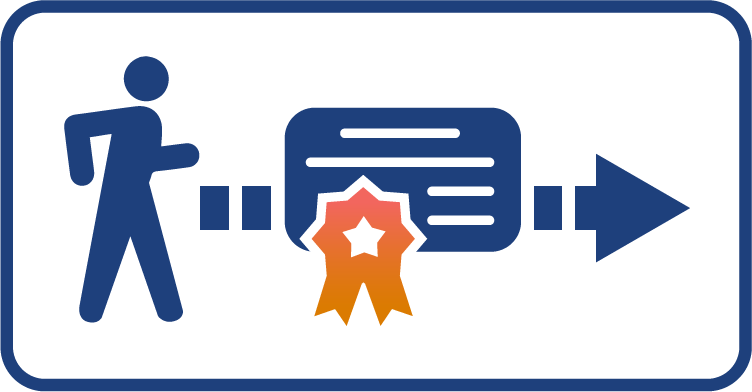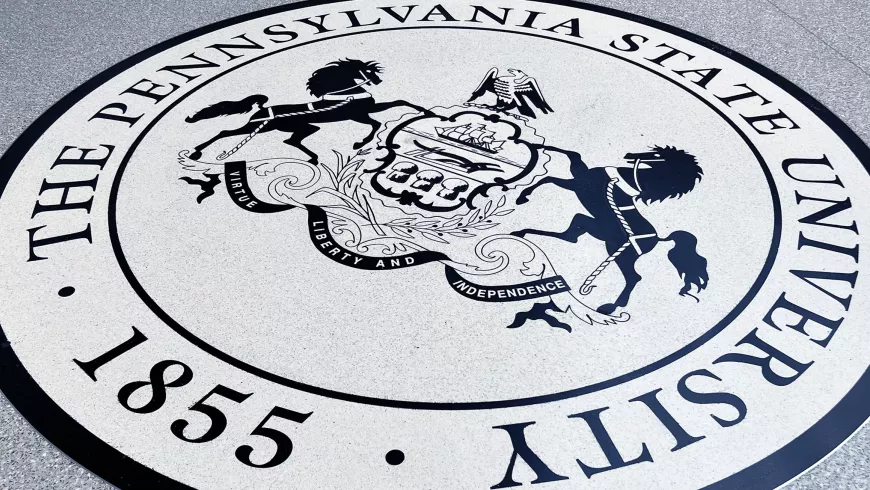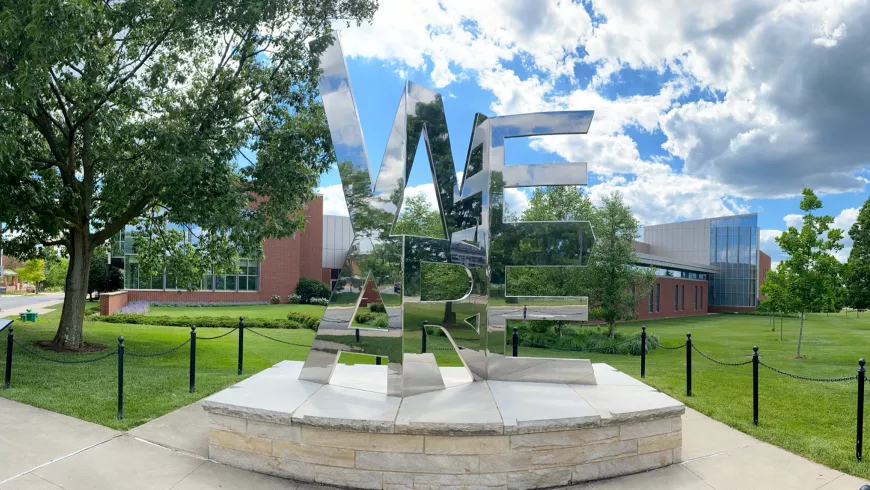100% Online
Complete your Penn State course work at your own pace and 100% online.
Application deadline
Credits and costs
Nationally Recognized

Gain Skills for the Growing IT Field with an Information Science Degree
Design systems, architectures, business processes, components, and programs to meet needs defined by the human context of business and industry.
Demonstrate, apply, and adapt problem-solving strategies using appropriate technologies and methods.
Analyze issues surrounding problems and opportunities in terms of the human, informational, and technological dimensions.
Deploy up-to-date, relevant, and appropriate techniques, methodologies, and tools necessary for understanding opportunities and constraints.
Assess the impact of information, computing, and technology on individuals, groups, organizations, society, and the world to make informed decisions from sociological, governmental, legal, and security perspectives.
Online IST Courses and Options
Online IST Courses and Options
Courses focus on developing theoretical foundations and real-world skills needed to incorporate information technology into different systems to improve system performance. You’ll study the frameworks needed to use information technology, as well as application-oriented experiences and skills.
To earn the Bachelor of Science in Information Sciences and Technology degree program, you must complete a minimum 125 credits.
- 84 credits required for the major
- 26 prescribed credits
- 13 additional credits
- 21 supporting courses and related areas credits
- 24 option credits (Design and Development)
- 8 credits of electives
- 45 General Education credits (12 of these credits are included in the requirements for the major)
Entrance-to-Major Requirements
To change your major to IST, you must have earned at least 27.5 credits with a cumulative grade point average of 2.0 and a C or better in the following courses:
- IST 110,
- IST 140 (or equivalent CMPSC 101 or CMPSC 121),
- IST 210,
- and IST 220.
Prescribed Courses (26 credits)
Students must earn a grade of C or better in all prescribed courses except STAT 200.
- 3credits
Overview of organizational structures and functions. Includes information processing and analytic perspectives of organizations.
- Prerequisite
IST 210 and IST 220
- 3credits
Interdisciplinary survey of topics and methods related to the human-centered design use and usability of information systems.
- Prerequisite
A grade of C or better in IST 240 or IST 242
- 3credits
The use, analysis, and design of information systems and technologies to organize, coordinate, and inform human enterprises.
- 3credits
Introduction to the concept of databases, including the storage, manipulation, evaluation, and display of data, and related issues.
- 3credits
Introduction to digital network topologies, transmission media, signal modulation, digital packet switching and routing, systems integration, communications management, and security.
- 3credits
Introduction to formal languages, mathematical logic, and discrete mathematics, with applications to information sciences and technology.
- Prerequisite
MATH 110 or MATH 140
- 3credits
Problem-based approach to technology integration by focusing on real-life problems faced by an organization.
- Prerequisite
ENGL 202C or ENGL 202D and seventh-semester standing (this course is intended for seniors)
- 1credit
Supervised off-campus, nongroup instruction including field experiences, practica, or internships. Written and oral critique of activity required.
- Prerequisite
prior approval of proposed assignment by instructor
- Note
Internships provide valuable experience for students; however, we recognize that situations vary and some students, due to work or other commitments, are unable to adjust their schedules. You are encouraged to contact your adviser to make arrangements for suitable activities in lieu of an internship.
- 4credits
Descriptive Statistics, frequency distributions, probability and normal distributions, statistical inference, linear regression, and correlation.
- Prerequisite
Placement into MATH 21 or higher.
Additional Courses (13 credits)
Students must earn a grade of C or better in all additional courses.
- 3credits
Methods of economic analysis and their use; price determination; theory of the firm; distribution.
- or:3credits
National income measurement; aggregate economic models; money and income; policy problems.
- 3credits
Writing for students in scientific and technical disciplines.
- Prerequisite
ENGL 15, ESL 15, ENGL 30, and 4th Semester standing OR ENGL 137H, ENGL 138T, and 4th Semester standing
- or:3credits
Writing reports and other common forms of business communication.
- Prerequisite
(ENGL 15 or ESL 15 or ENGL 30) and 4th-semester standing OR (ENGL 137H and ENGL 138T) and 4th-semester standing
- 3credits
A first course in concepts and skills for application development.
- Prerequisite
C or better in MATH 21 or placement above the level of Math 21 in the mathematics placement test.
- or:3credits
Fundamentals of computational thinking, including reasoning about problems at multiple levels of abstraction, and analyzing code for its behavior, efficiency, and correctness.
- Prerequisite
MATH 21 or satisfactory performance on the mathematics placement examination
- 4credits
Introduces and develops the mathematical skills required for analyzing change, and the underlying mathematical behaviors that model real-life economics and financial applications. Develops student knowledge of calculus techniques, and how to use a calculus framework to develop critical thinking and problem-solving skills.
- Prerequisite
MATH 022 or satisfactory performance on the mathematics placement examination
- or:4credits
Introduces and develops the mathematical skills required for analyzing change and creating mathematical models that replicate real-life phenomena. Develops student knowledge of calculus techniques and how to use the calculus environment to develop critical thinking and problem-solving skills.
- Prerequisite
MATH 22 and MATH 26 or MATH 26 and satisfactory performance on the mathematics placement examination or MATH 40 or MATH 41 or satisfactory performance on the mathematics placement examination.
Supporting Courses and Related Areas (21 credits)
- Emerging Issues and Technologies (3 credits): Please consult your adviser to learn about additional options for this course requirement.
- Foreign Language (12 credits): Attainment of third-level proficiency in a single foreign language. Proficiency must be demonstrated by either examination or course work.
- International Courses in Foreign Cultures (6 credits): Select 6 credits in international courses in foreign culture from University-approved list (semesters: 5–8).
Design and Development Option (24 credits)
- 3credits
Introduction to object-oriented applications, including applications in an Object-Oriented Design (OOD) language or OOD languages.
- Prerequisite
A grade of C or better in IST 242 or CMPSC 221
- 3credits
Intermediate application development including algorithms, data structures, and object-oriented concepts.
- Prerequisite
A grade of C or better in IST 140 or CMPSC 121 or IST 240
Studio Courses for the Design and Development Option (select 3 credits)
Students must earn a grade of C or better in all studio courses for the option.
- 3credits
Introductory design and development studio course for IST and SRA students.
- Prerequisite
A grade of C or better in IST 242 or permission of program
- 3credits
Second of two design and development studio courses for IST and SRA students.
- Prerequisite
A grade of C or better in HCDD 311 or permission of program
Additional Courses for the Design and Development Option (6 credits)
Students must earn a grade of C or better in all additional courses for the option.
- 3credits
Introduction to distributed-object computing and its use in client/server and real-world computing applications.
- Prerequisite
A grade of C or better in HCDD 311
- 3credits
Introduction to the engineering of complex software systems, including software system specification, design and implementation, integration and test, and evolution.
- Prerequisite
A grade of C or better in HCDD 311
Supporting Courses and Related Areas for the Design and Development Option (9 credits)
Select 9 credits from College-approved list in consultation with an adviser.
Electives (8 credits)
Courses chosen in consultation with an adviser.
General Education Requirements
Some General Education requirements may be satisfied by courses required for the major. Students should work with an adviser to select courses.
- Foundations: 15 credits
All courses require a grade of C or better. Inter-Domain courses may not be used for foundations requirements.- Writing/Speaking: 9 credits
- Quantification: 6 credits
3-6 credits are selected from mathematics, applied mathematics, and statistics; 3 credits may be selected from computer science or symbolic logic.
- Knowledge Domains: 15 credits
Inter-Domain courses may not be used for knowledge domain requirements.- Health and Wellness (GHW): 3 credits
- Natural Sciences (GN): 3 credits
- Arts (GA): 3 credits
- Humanities (GH): 3 credits
- Social and Behavioral Sciences (GS): 3 credits
- Integrative Studies: 6 credits
- Inter-Domain course work: 6 credits
- Exploration: 9 credits
- Natural Sciences (GN) (may be Inter-Domain): 3 credits
- GA, GH, GN, GS, and Inter-Domain courses: 6 credits
May include 3 credits of World Language course work beyond the requirements of the student’s degree program or at the 12th credit level, whichever is higher.
These General Education Requirements are for students who started in summer 2023 or later. Students who started earlier can review the prior version of the general education requirements.
Course Availability
If you're ready to see when your courses will be offered, visit our public LionPATH course search (opens in new window) to start planning ahead.
Start or Advance Your Career

Start or Advance Your Career
The demand for college-educated IT professionals continues to increase as organizations from retail to manufacturing and business to science improve and upgrade their IT infrastructures.
Job Titles Related to This Degree
The following roles are often held by people with this type of degree:
- Application Programmer Analyst
- Database Administrator (DBA)
- Database Architect
- Information Technology Manager (IT Manager)
- Systems Administrator
- Web Developer
Employment Outlook for Occupational Fields Related to This Degree
Estimates of employment growth and total employment are provided by the U.S. Bureau of Labor Statistics and are subject to change. While these occupations are often pursued by graduates with this degree, individual outcomes may vary depending on a variety of factors. Penn State World Campus cannot guarantee employment in a given occupation.
Computer and Information Systems Managers
Web Developers
Network and Computer Systems Administrators
Database Architects
Database Administrators
Computer Programmers
Career Opportunities for Graduates
IT professionals often work as associate systems designers, network managers, application programmers, web designers, and web administrators. Robert Half Technologies, leading provider of IT professionals on a project and full-time basis, cites the following four industries in which IT growth is expected:
Health care: In an aging population, the need for constant technology upgrades and government funding should result in continuing rapid growth for IT in health care and related industries.
Government: U.S. stimulus funding is likely to fuel IT hiring, both in government agencies and in firms that rely on government contracts.
Financial services: Technology investments and hiring may increase as firms strive to meet reform and compliance requirements.
Education: Technology investments and hiring should remain strong, thanks to stimulus funding, rising student enrollments at all levels, and the growth of e-learning.
Career Services to Set You Up for Success

From the day you're accepted as a student, you can access resources and tools provided by Penn State World Campus Career Services to further your career. These resources are beneficial whether you're searching for a job or advancing in an established career.
- Opportunities to connect with employers
- Career counselor/coach support
- Occupation and salary information
- Internships
- Graduate school resources
Upcoming Events
Ready to Learn More?
Get the resources you need to make informed decisions about your education. Request information on this program and other programs of interest by completing this form.
Ready to take the next step toward your Penn State bachelor's degree?
Costs and Financial Aid
Costs and Financial Aid
Learn about this program's tuition, fees, scholarship opportunities, grants, payment options, and military benefits.
Costs and Financial Aid
Undergraduate Tuition
Undergraduate tuition is calculated based on the number of credits for which you register and the number of total credits you have accrued at or transferred to Penn State.
Tuition is due shortly after each semester begins and rates are assessed every semester of enrollment.
2025–26 Academic Year Rates
| How many credits do you plan to take per semester? | If you have 59 or fewer credits | If you have 60 or more credits |
|---|---|---|
| 11 or fewer | $638 per credit | $685 per credit |
| 12–19 | $7,755 per semester | $8,371 per semester |
Undergraduate students taking more than 19 credits will be charged the flat tuition rate plus the regular per credit hour rate for each credit above 19.
Financial Aid and Military Benefits
Some students may qualify for financial aid. Take the time to research financial aid, scholarships, and payment options as you prepare to apply. Federal financial aid may only be used to pay for credits used to satisfy program requirements.
Military service members, veterans, and their spouses or dependents should explore these potential military education benefits and financial aid opportunities, as well.
Additional Cost of Attendance Details
To view the detailed list of cost of attendance elements:
- visit the Tuition Information site
- click the plus sign to expand the table
- select a semester from the World Campus row
Earn a Valuable Credential along the Way

Earn a Valuable Credential along the Way
Show mastery of specific subjects before your degree is complete. Thanks to shared courses across programs, students can often earn an additional credential along with their degree in less time than if they earned them separately.
Additional Credentials Related to This Degree
In the IT profession, continued learning is key to advancing your career. With this in mind, you might want to enroll in the associate degree in IST or the certificate in IST programs as you work toward your bachelor’s degree. Many of the credits in these programs can be applied to the requirements for your bachelor’s degree, so that means you can benefit from Penn State's highly respected name on your résumé even sooner.
Develop practical IT skills through hands-on projects and an internship. This online degree program is designed for working professionals without formal IT training who want to pursue a career in technology management.
Learn more about the Associate in Science in Information Sciences and TechnologyBuild the foundation for a leadership role in any IT–related field. This 12-credit certificate program focuses on practical skills that can be immediately implemented in the information technology workplace.
Learn more about the Undergraduate Certificate in Information Sciences and TechnologyWho Should Apply?
Who Should Apply?
This degree is particularly suitable if you can bring your current, real-world IT experience to your studies; however, you do not need previous experience in the field.
The online bachelor’s degree in information sciences and technology is a good fit if you:
- are currently employed in IT, have an associate degree, and want to continue your education to advance your career
- are currently employed in other professional or preprofessional positions and wish to expand your employment opportunities
- are already employed in IT and want to enter a bachelor’s degree program, but you have no previous credits toward an IT degree
- want to change your current career and do not have an IT background
Set Your Own Pace

Set Your Own Pace
Whether you are looking to finish your program as quickly as possible or balance your studies with your busy life, Penn State World Campus can help you achieve your education goals. Many students take one or two courses per semester.
Our online courses typically follow a 12- to 15-week semester cycle, and there are three semesters per year (spring, summer, and fall). If you plan to take a heavy course load, you should expect your course work to be your primary focus and discuss your schedule with your academic adviser.
To Finish Your Degree in Two to Three Years
- Take 6 courses each semester
To Finish Your Degree in Three to Four Years
- Take 4–5 courses each semester
To Finish Your Degree in Five or More Years
- Take 2–3 courses each semester
Timelines may vary for students transferring credits from another school or based on course availability.
Convenient Online Format
This program's convenient online format gives you the flexibility you need to study around your busy schedule. You can skip the lengthy commute without sacrificing the quality of your education and prepare yourself for more rewarding career opportunities without leaving your home.
A Trusted Leader in Online Education

Penn State has a history of more than 100 years of distance education, and World Campus has been a leader in online learning for more than two decades. Our online learning environment offers the same quality education that our students experience on campus.
How to Apply to Penn State

How to Apply to Penn State
Apply by October 31 to start January 12
Application Instructions
Deadlines and Important Dates
Complete your application and submit all required materials by the appropriate deadline. Your deadline will depend on the semester you plan to start your courses.
Spring Deadline
Apply by October 31 to start January 12Summer Deadline
Apply by March 15 to start May 18Fall Deadline
Apply by June 30, 2026, to start August 24, 2026
New students are encouraged to complete the FAFSA by March 1. Please visit the Office of Student Aid website for more information about applying for financial aid and recommended deadlines.
Steps to Apply
To apply for this program, you must be a high school graduate, or have completed your GED.
This degree program includes Entrance-to-Major requirements (ETMs). After you are admitted to Penn State, you’ll complete them during your first few semesters to officially become an IST major. If you satisfy these requirements with transfer credits, you’ll be admitted directly into the major.
You are also required to satisfy the entrance-to-college requirements to be admitted into the College of Information Sciences and Technology by any of the following methods:
- completing three units of mathematics (four are recommended), selected from any combination of algebra, geometry, and trigonometry. The college requires one-half unit of trigonometry or higher-level math within the required three units
- completing MATH 022 (College Algebra II and Analytic Geometry) or MATH 026 (Plane Trigonometry) OR a higher-level math course offered by Penn State, such as any one of the following:
1. MATH 040 (Algebra, Trigonometry, and Analytic Geometry)
2. MATH 041 (Trigonometry and Analytic Geometry)
3. MATH 110 (Techniques of Calculus I)
4. MATH 111 (Techniques of Calculus II)
5. MATH 140 (Calculus with Analytic Geometry I)
6. MATH 141 (Calculus with Analytic Geometry II) - completing a trigonometry or higher-level course at another accredited institution with a grade of C or better
- receiving sufficient scores on Advanced Placement trigonometry or calculus exams
Important: Penn State's math placement exam results are NOT sufficient for satisfying the entrance into the College of IST requirement. The requirement must be demonstrated by letter grade or transfer credit. For more information about the entrance into the College of IST requirement for this program, contact an adviser.
Once you are admitted to the College of Information Sciences and Technology, you will work closely with your academic adviser to gain entrance to the bachelor's degree in information sciences and technology.
You will need the following items to complete your application:
High school transcripts or GED transcript — First-year applicants are required to submit Self-Reported Academic Records (SRAR) when applying. Official high school transcripts for first-year applicants will only be required at the time a student accepts an offer of admission to Penn State.
Transfer international students will need to submit their high school transcript before their application can be reviewed.
Official college or university transcripts and/or official military transcripts (if applicable) — All college or university transcripts are required regardless of the length of time that has passed, the grades earned, or the accreditation of the institutions attended. Acceptance of transfer credit toward your degree is subject to final approval by the academic department. For detailed information, see the Transfer Students page.
Transcripts not in English must be accompanied by a certified translation.
English Proficiency — The language of instruction at Penn State is English. With some exceptions, international applicants must take and submit scores for the Test of English as a Foreign Language (TOEFL) or International English Language Testing System (IELTS). Minimum test scores and exceptions are found in the English Language Proficiency section on the Undergraduate Admissions International Requirements page. Visit the TOEFL website for testing information. Penn State's institutional code is 2660.
To begin the online application, you will need a Penn State account.
Create a New Penn State Account
If you have any problems during this process, contact an admissions counselor at [email protected].
Please note: Former Penn State students may not need to complete the admissions application or create a new Penn State account. Please visit our Returning Students page for instructions.
Accessing MyPennState
The MyPennState Portal provides access to our online admissions services. Before accessing MyPennState, you must have a Penn State account that will be used to access all Penn State systems. After creating an account, you will receive a unique Penn State User ID. You will need to enter your User ID followed by @psu.edu when signing in to MyPennState and other Penn State sites. For example, you should be entering something like '[email protected]' in the Sign In field.
The application consists of six sections:
- Application Setup
- Program of Study
- Citizenship and Residency
- Academics and Experience
- Miscellaneous
- Review and Submit
Application Setup
Be sure to select "Online" for the "How would you like to complete your degree" question if you plan to attend Penn State World Campus.
The rest of this section will ask some basic questions about your education experience and military affiliation.
Program of Study
You will choose the degree type and then the starting semester.
Your starting campus will be selected as Penn State World Campus by default as long as you picked "Online" in your Application Setup. Click Continue.
On the Choose a Program page, select your intended major from the list.
Review your selection on the summary screen and click Continue to move on to the Citizenship and Residency section.
Citizenship and Residency
Complete the series of questions about your citizenship status, demographic information, Pennsylvania residency status, and family history.
Academics and Experience
You will need to enter academic experience information about your high school and any attempted courses at a college or university after high school.
The Education Gap Statement offers a place to explain any time that has elapsed between your high school graduation and your anticipated enrollment at Penn State. Please provide a summary of why that gap occurred. Some examples that would explain a gap in your education include work, family, attending another college or university, etc.
Miscellaneous
In the Miscellaneous section, you will provide any program-specific requirements (e.g., a personal statement), information about activities, and financial aid information.
Review and Submit
Review your information, digitally sign your application, and provide payment for the application fee ($65 domestic or $75 international).
High School Transcripts and Academic Record
After your application is completed, you will also need to self-report your high school course work before the application deadline. You will be directed to fill out the Self-Reported Academic Record (SRAR). It is helpful to have a high school transcript available when completing this section. In the third section, you'll select your program of study and campus.
Official high school transcripts or GED transcript, along with records from high school, are required, regardless of the length of time that has passed.
Include any college/university transcripts (required), military transcripts, and Proof of English Language proficiency (if applicable). SAT/ACT scores are not required if you are identified as an adult learner or transfer student.
All official documents should be sent to:
Undergraduate Admissions Office
The Pennsylvania State University
201 Shields Building
University Park, PA 16802You can also have your transcripts sent electronically through Parchment, eScript-Safe, or the National Clearinghouse directly to Penn State from the college/university where course work was attempted.
Acceptance
After receiving your application, application fee, and all required materials, your application will be evaluated for admission. You can check your application status online. This will provide the most up‐to‐date information about the status of your application and is updated once daily, before 8:00 a.m. (ET). Once a decision has been made regarding your application, it will be available to you through the MyPennState portal.
For information on when you can expect an admissions decision, visit the Dates and Deadlines page of the Undergraduate Admissions website. Make sure you click the "+" sign to see these dates for World Campus Applicants (First-Year and Transfer).
5. Complete the application.
Admissions Help
If you have questions about the admissions process, contact an admissions counselor at [email protected].
Contact Us

Contact Us
Have questions or want more information? We're happy to talk.
To learn more about the Bachelor of Science in Information Sciences and Technology, please contact:
World Campus Admissions Counselors
Phone: 814-863-5386
[email protected]
Learn from the Best
Learn from the Best
The B.S. in Information Sciences and Technology is offered in partnership with the Penn State College of Information Sciences and Technology, which is a leader among an emerging group in higher education known as i-schools, or information schools.
Your faculty members in this online program are the same faculty who teach our respected on-campus programs. They are a diverse group of thought leaders from many fields, including business, information science, computer science, engineering, psychology, chemistry, and artificial intelligence.
Faculty
Michael R. Bartolacci
- DegreePh.D., Industrial Engineering, Lehigh University
- DegreeMBA, Lehigh University
- DegreeB.A., Engineering, Lafayette College
Dr. Michael R. Bartolacci is an associate professor of information sciences and technology at Penn State Berks. He conducts research in telecommunications modeling, electronic commerce modeling, customer relationship management, manufacturing modeling, and international aspects of telecommunications.
Nannette D'Imperio
- DegreeM.S., Computer Education, Philadelphia University
- DegreeB.S., Elementary Education, concentration in Mathematics, West Chester University
Nannette D'Imperio is a lecturer of information sciences and technology at Penn State Brandywine. Her areas of interest are programming languages, web-based learning, and applications.
James (Jim) Farrugia
- DegreePh.D., Spatial Information Science and Engineering, University of Maine
- DegreeM.S., Library Science, University of North Carolina at Chapel Hill
- DegreeB.A., Mathematics, East Stroudsburg University
Dr. James (Jim) Farrugia is an assistant teaching professor of information sciences and technology. His areas of interest include programming, software development, data synthesis, and design and development.
Fred Fonseca
- DegreePh.D., Spatial Information Science and Engineering, University of Maine
- DegreeM.S., Public Administration and Computer Science, Government School of the Joao Pinheiro Foundation, Minas Gerais, Brazil
- DegreeB.S., Mechanical Engineering, Catholic University of Minas Gerais, Brazil
Dr. Fred Fonseca joined Penn State in 2001 as an assistant professor. His work in the areas of research, geographic information science, information science, and information systems has led to many journal papers, research grants from NSF and other agencies, and successful master's and doctoral students.
Chris Gamrat
- DegreePh.D., Learning, Design, and Technology, Penn State
- DegreeM.Ed., Instructional Systems, Penn State
- DegreeB.S., Management Information Systems, Penn State
Dr. Chris Gamrat served as an instructional designer for the College of IST since 2013 and became a faculty member in 2022. Prior to joining IST, Dr. Gamrat served as a technology specialist for the NASA Aerospace Education Services Project at the Penn State College of Education, starting in 2008. His research interests include inclusive teaching, innovations in teaching and learning, and microcredentials.
Katherine Hamilton
- DegreePh.D., Industrial/Organizational Psychology, Penn State
- DegreeM.S., Industrial/Organizational Psychology, Penn State
- DegreeB.A., Psychology, Florida International University
Dr. Katherine Hamilton, an assistant teaching professor of information sciences and technology, teaches statistics and research methods. She conducts research on team effectiveness, particularly in the areas of virtual teams, team cognition, and team conflict.
David M. Hozza
- DegreeMPS, Information Sciences (Cybersecurity), Penn State
- DegreeB.S., Computer Science and Management, East Stroudsburg University
David M. Hozza is a lecturer in information sciences and technology. Prior to his appointment, he had a 30-year career in the IT industry, with responsibilities in storage architecture, systems administration, data analysis, and leadership management. His areas of interest include cloud computing, cybersecurity, data protection and storage, and enterprise integration.
Johnson Kinyua
- DegreePh.D., Computer Science, University of Cambridge, United Kingdom
- DegreeM.S., Digital Communications, University of Kent at Canterbury, United Kingdom
- DegreeB.S., Electronics Engineering, University College London, United Kingdom
Dr. Johnson Kinyua has been an associate teaching professor with the College of IST since 2018. His career spans more than 35 years of teaching, research, and industry experience. He served as a director of a school for six years and as a dean for five years at different universities. His teaching interests are in cybersecurity, enterprise information systems, networks, computer architecture, operating systems, software engineering, database management systems, object-oriented programming, distributed database systems, and enterprise integration.
Sadan Kulturel-Konak
DegreePh.D., Industrial and Systems Engineering, Auburn UniversityDr. Sadan Kulturel-Konak is a professor of management information systems at Penn State Berks. Her primary research focus is modeling, analysis, and optimization of complex systems using metaheuristic approaches, including Tabu search and genetic algorithms, combined with techniques from probability and operations research. Primary applications of her research include facility layout, redundancy allocation, orienteering, and scheduling.
Lynette Kvasny Yarger
- DegreePh.D., Computer Information Systems, Robinson College of Business, Georgia State University
- DegreeM.S., Computer and Information Systems, Robinson College of Business, Georgia State University
- DegreeB.S., Computer and Information Systems, Mercy College
Dr. Lynette Kvasny Yarger is an associate professor in the College of Information Sciences and Technology. Her areas of study include community computing initiatives in economically oppressed communities, the underrepresentation of women and minorities in the IT workforce, ethics and gender identity performance in online spaces, and the use of social media for political activism and social justice.
Richard Lomotey
- DegreePh.D., Computer Science, University of Saskatchewan
- DegreeMSc., Computer Science, University of Saskatchewan
- DegreeB.Sc., Computer Science, University of Cape Coast
Dr. Richard Lomotey is a tenured associate professor of information sciences and technology at Penn State. He teaches a variety of courses at the undergraduate and graduate levels, and his research focuses on emerging technologies (such as mobile computing, IoT, and machine learning) in diverse domains, including health, agriculture, gamification, and enterprises.
Alison R. Murphy
- DegreePh.D., Information Sciences and Technology, Penn State
- DegreeB.S., Information Sciences and Technology, Penn State
Dr. Alison R. Murphy is an assistant teaching professor of information sciences and technology. She enjoys teaching students to think critically about the socio-technical impacts of technology on individuals, organizations, and society. She is also dedicated to researching how to improve the usability of health information technology for both individuals and organizations through the use of qualitative methods and UX design principles.
Joseph Oakes
- DegreeM.S., Information Science, Penn State
- DegreeB.S., Information Systems, Philadelphia University
Joseph Oakes is a senior lecturer in information sciences and technology at Penn State Abington. His areas of interest are android, software development for mobile devices, gaming, cryptography, and cluster networks.
Gregory O'Toole
DegreePh.D., Media and Communication, European Graduate School, Saas-Fee, SwitzerlandDr. Gregory O'Toole is a lecturer in information sciences and technology at Penn State Abington. His areas of interest are open source web design and development, web research, and education.
Kaamran Raahemifar
- DegreePh.D., University of Windsor
- DegreeMASc, University of Waterloo
Dr. Kaamran Raahemifar is a professor in the artificial intelligence and data science programs in the Penn State College of Information Sciences and Technology. He has several decades of combined experience in teaching, research, and administrative/executive services. He has research and teaching interests in applied optimization, data modeling and prediction, small and large system simulation and design, signal anomaly detection and testing, blockchain, data science, artificial intelligence, user experience, and smart-connected devices.
Syed Rizvi
- DegreePh.D., Computer Science and Engineering, University of Bridgeport
- DegreeM.S., Computer Engineering, Old Dominion University
- DegreeB.S., Computer Engineering, Sir Syed University of Engineering and Technology
Dr. Syed Rizvi is an associate professor in information sciences and technology at the Penn State Altoona campus. His research interests lie at the intersection of computer networking, network security, and machine learning. Dr. Rizvi teaches cybersecurity, risk analysis, and IST courses such as fundamentals of information security, networking and telecommunications, secure software engineering, security risk assessment, network security, incident response handling, and capstone projects. He is a member of the IEEE Communications Society and ACM.
Maryam Roshanaei
- DegreePh.D., Computer Networks, Kingston University London
- DegreeB.Sc., Joint Honor Degree in Mathematics and Computing, Kingston University London
Dr. Maryam Roshanaei is an assistant professor of cybersecurity and IST at Penn State Abington. She teaches undergraduate- and graduate-level courses in security and risk analysis, information security and cybersecurity, mobile technologies, and digital forensics and crime. She is an active researcher with expertise in AI, cyber trust, cyber hygiene, critical infrastructure protection, future networks (FN), cybersecurity, digital forensics and crime, Internet privacy, and surveillance. She is an active member of BSI, ISO, and ITU-T standards committees.
News



